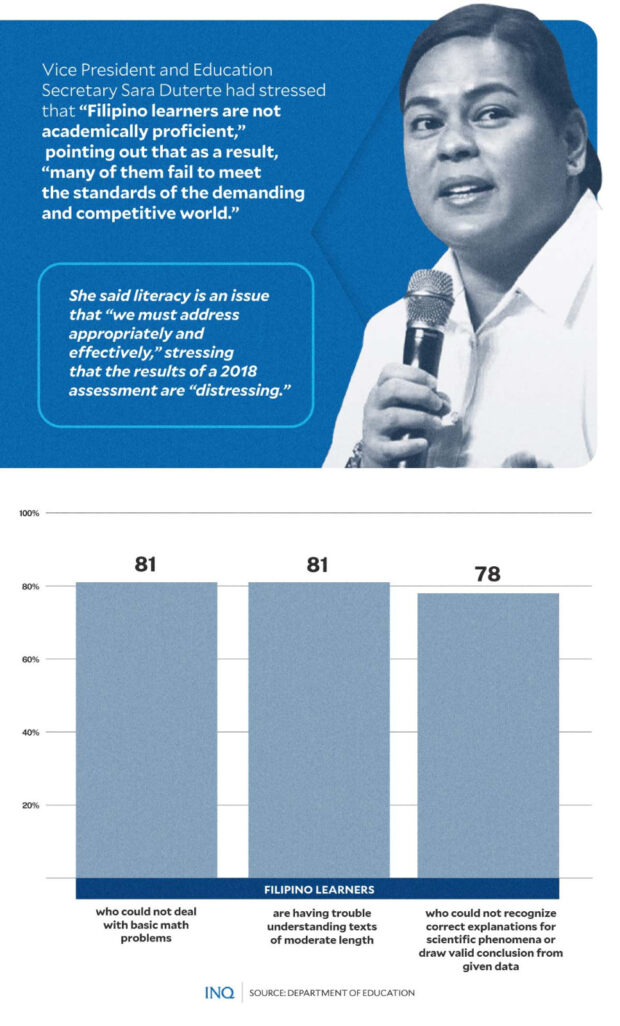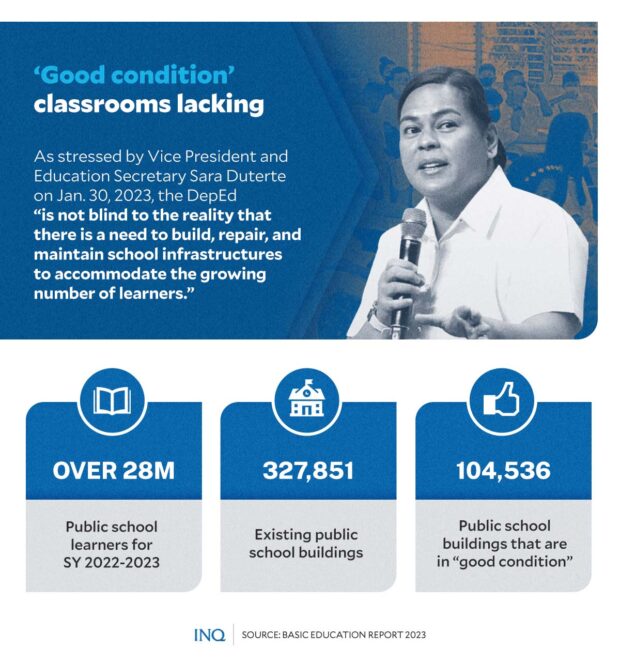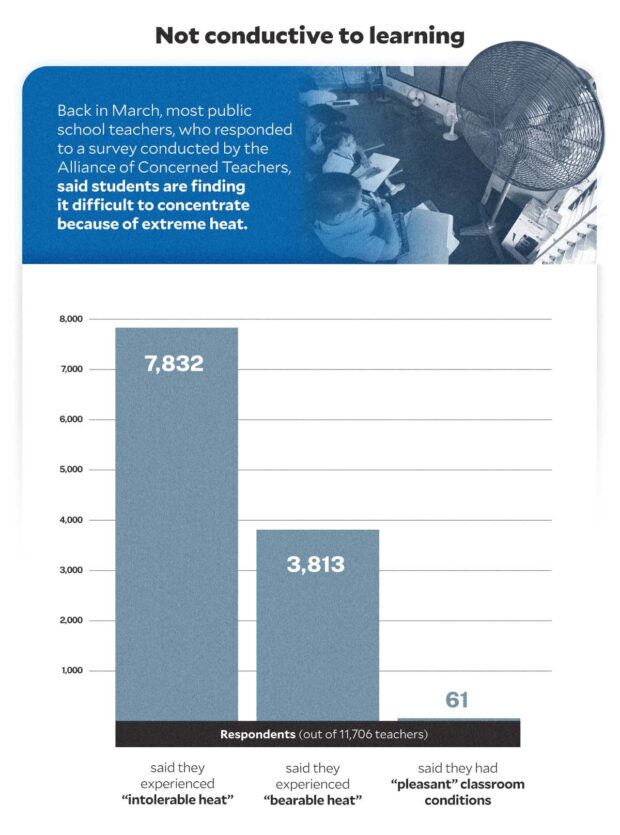New DepEd order: Laying bare classroom walls and learning woes, too

INQUIRER FILE PHOTO
MANILA, Philippines—In response to the Department of Education’s directive to rid classrooms of decorations, Jomel (not his real name), a high school teacher, started making his classroom walls “bare.”
Talking to INQUIRER.net, Jomel, who has been a teacher for over five years now, said while he was painting the classroom walls that were previously adorned with visual aids: “It is regrettable because there are instances that when they look at these [visual materials] they really learn something.”
According to Raymond Basilio, secretary general of the Alliance of Concerned Teachers (ACT), teachers should be the one to decide whether to keep or remove the learning aids.
“They are more keen on the do’s and don’ts, and the interventions needed inside their respective classrooms,” he told INQUIRER.net when asked to comment on DepEd Order No. 21, telling school officials to keep classroom walls bare.
Issued on Aug. 3, over a week before the Brigada Eskwela, the order pointed out that “classroom walls shall remain bare and devoid of posters, decorations, or other posted materials.”
RELATED STORY: ACT to DepEd: Remove extra tasks instead of visual aids
This, as the DepEd said “[public] schools shall ensure that school grounds, classrooms and all its walls, and other school facilities are clean and free from unnecessary artwork, decorations, tarpaulin and posters at all times.”
Vice President and Education Secretary Sara Duterte explained that “classrooms should be clean so that the attention of our students is in their teacher, their book, or their activity.”

GRAPHIC Ed Lustan
She told Radyo Pilipinas that decorations and everything that are attached or written on the walls of a classroom should be removed, stressing that “classrooms should be free from clutter.”
DepEd spokesperson Michael Poa told Radyo 630 that the directive to “take out everything” is “what it is,” pointing out what Duterte had said—that classrooms should be clear, even from photos of government officials, including the President, and heroes, like Dr. Jose Rizal.
‘There should be a review’
Joanne Trina Moreno-Javier, member of the Board of Trustees of the Psychological Association of the Philippines, said it would be best for the DepEd to consult teachers at different levels—kindergarten, grade school, and high school.
Javier, a certified developmental psychologist, told INQUIRER.net via FB Messenger that especially among the younger age groups, having visuals and print-rich learning environments “will be helpful to further stimulate their senses, as this is how they best learn — through their senses.”
“There is truth to the matter, though, that less clutter will also be advisable,” she said.
Pamela Joy Capistrano, a university instructor, who was concerned as a parent, looked as an academic into studies regarding scrapping classroom decorations and its relation to learning.
She said on X (formerly Twitter) that there are a lot of studies looking at the relationship between architectural classroom designs and student achievements, “but there are basically only two heavily influential research projects that focus specifically on classroom decorations.”
However, she told INQUIRER.net via FB Messenger that “there is a need to return to the studies because the researchers themselves were very explicit” about (1) the limitations of the studies, which were focused on kindergarten in 2014 and in early grades in 2022; (2) how they do not endorse zero classroom decorations; and (3) recommending a minimalist approach to classroom decorations.
She said it would be beneficial for the DepEd to review the blanket directive, “especially for the welfare of young learners,” saying that for most children, the school is often a safe space where they have the chance to be kids and have fun while learning.
According to Javier, “it is then better to regulate what is being posted or have a better organized manner of arranging these visuals,” like “considering the position on where these visuals are placed, size, color, and most importantly, [the] appropriateness to the grade or age group.”
Class size is ‘real problem’
While the order is somehow advantageous, too, especially for some teachers, like Jomel, who pointed out that bare classroom walls would indicate lesser expenses, Javier said “it would be best to give attention on how to make the classroom a better learning environment.”
She said the fact that the teacher remains to be the most important “visuals” in the classroom, “it will be futile to argue whether these decorations are placed or pulled down from walls if the best visual is not equipped to make better use of these seemingly secondary learning aids in the classroom.”
“The point here is that a trained teacher is paramount, with or without consideration of the physical classroom environment,” Javier said, stressing that the DepEd should listen to teachers’ “take and suggestions.”
According to Basilio, there are a lot of problems that the DepEd should instead address, like the lack of teachers and classrooms, which are the reasons that class sizes are bloated.
READ: As PH students fall into learning abyss, DepEd told to focus on right solutions
Based on an article published by the The Rensselaerville Institute, a non-profit organization based in the United States, instruction quality and delivery style, class size, parent involvement, peer relationships, assessment, and school facilities are some of the significant factors that help students learn and excel academically.

GRAPHIC Ed Lustan
“If the government wants learners to focus on their teachers, the solution is to reduce the class size and provide teachers and students with enough and necessary teaching and learning materials,” Basilio said.
ACT previously stated that teachers with seven to eight teaching loads are handling 30 to 50 students for every class while also attending to administrative responsibilities in their schools.
RELATED STORY: Legit or deceptive? Call to hire 30,000 teachers per year not new
Basilio pointed out that if the government wants teachers, too, to focus on teaching their students, they should be stripped of their administrative tasks and be given enough opportunities for continuing professional development.
Lack of classrooms
Capistrano stressed that it is also critically important to look at other physical design elements, saying that “so many public school classrooms in the Philippines are cramped, dark, [and] badly ventilated.”
According to Duterte’s Basic Education Report 2023, which was presented last Jan. 30, the DepEd is “not blind to the reality that there is a need to build, repair, and maintain school infrastructures to accommodate the growing number of learners.”

GRAPHIC Ed Lustan
Based on DepEd data, there are over 28 million Filipino learners in public schools for the school year 2022-2023, but there are only 327,851 school buildings. Out of which, only 104,536 are in “good condition.”
RELATED STORY: DepEd: Institutionalizing hybrid setup may mitigate classroom shortage
Last March, most public school teachers, who responded to a survey conducted by ACT, said students are finding it difficult to concentrate because of extreme heat during the dry season.

GRAPHIC Ed Lustan
This, as out of the 11,706 teacher-respondents, 7,832 said they experienced “intolerable heat,” 3,813 said they experienced “bearable heat,” while only 61 said they had “pleasant” classroom conditions.
READ: Extreme heat leads to shorter class hours, blended learning in QC schools
Most respondents pointed out that the extreme heat was distracting students from learning, especially when inside a classroom with 50 students, which is way higher than the standard class size of only 35 students.
Out of the 11,706 teacher-respondents, who were allowed to select more than one answer, 10,140 said children were having difficulty concentrating on lessons, 4,638 said there was increased absenteeism, while 4,352 said the extreme heat triggered pre-existing medical conditions.
Capistrano said: “Just as crucial to learning are students’ physical and emotional states. Is the classroom not too warm, is it bright, is it adapted to our needs? Is the classroom a place where students feel safe and welcome? Is school a place we learn to love, and where we love to learn?”
